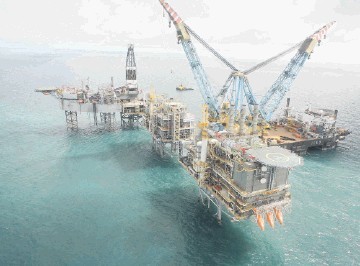
THE latest UKCS oil and production statistics from the Department of Energy and Climate Change (DECC) show big falls. June’s output averaged 946,982 barrels per day, which was down 12.4% on June 2010. Gas averaged 4,004million (4billion) cu.ft, down 26.5% year on year.
The monthly statistics can be variable but during the first six months of 2011 UKCS oil output was 16% down on the same period last year, while gas slumped 27%.
Declines of this magnitude have huge implications not only for the industry but also the UK economy, particularly the balance of payments.
There has been much good news from the industry in recent weeks, notably the £4.5billion investment in the Clair Ridge project. There is a lot of development work underway and Oil & Gas UK recently predicted that annual capital investment could reach £10billion over the next few years.
Notwithstanding, the industry seems also to be in serious decline. We all know the North Sea is mature and that UKCS production is long past peak.
Oil output halved over the decade to 2010, with an average annual decline of about 5%. Output fell every year except in 2007 when the large Buzzard field began full-scale production.
In marked contrast to declining production, UK oil consumption remained relatively stable over the decade, rising from 78.6million tonnes in 2000 to 83.0million in 2005 before falling to 73.7million in 2010.
An obvious consequence of the output fall is that the UK changed from being a substantial net exporter of oil to a net importer in 2006, and also a net importer of gas in 2004. Imports have increased since then and that trend will undoubtedly continue. The import bill is enormous and is having a very negative impact on our balance of payments.
Regular readers of Energy will know that I have had long-standing disagreements with both DECC and Oil & Gas UK over the last few years about the accuracy – or inaccuracy – of their annual projections / forecasts. I have long argued that both have been too optimistic and the latest statistics strongly support my arguments.
The DECC projections are based on detailed field-by-field data provided by operators. So they are identical or very similar to OGUK’s.
The two bodies’ projections or forecasts show UK output declining at about 5% per year. I used those assumptions in various reports until I had to do a detailed analysis and came up with more pessimistic conclusions.
For the last year, I have assumed an annualised decline of about 10%. Even that may prove optimistic, given the latest figures.
DECC’s website gives statistics for every UK field. I have examined all to try to identify the underlying reasons for the recent massive falls.
The main one seems to be rising decline rates – as much as 20% per annum for many mature fields. There have also been unusual problems at some of the biggest fields such as Buzzard, Schiehallion and Foinaven, which hopefully have been, or are being, resolved. Indeed, new fields since Buzzard have made a disappointingly small contribution to both oil and gas production.
I am surprised at the recent rates of decline because I expected that high commodity prices would encourage companies to extract every last molecule of resource. There are a few encouraging examples of that but unfortunately only a few.
On a more positive note, there are about 30 fields currently under development. Most are small subsea tiebacks but there are a few big ones, notably Laggan-Tormore (Total) in the West of Shetland area, and Jasmine (ConocoPhillips). In addition there will be substantial investment in the ongoing development or redevelopment of some existing fields, notably Clair Ridge (BP) and Schiehallion and Foinaven in Quad 204 (also BP).
When the foregoing begin production they should make a substantial contribution to slowing down the rates of decline but in the short run it seems clear that the DECC and OGUK projections – and even those I made last year – are too optimistic. That is very bad news for the UK economy.
Tony Mackay is the managing director of energy economists Mackay Consultants